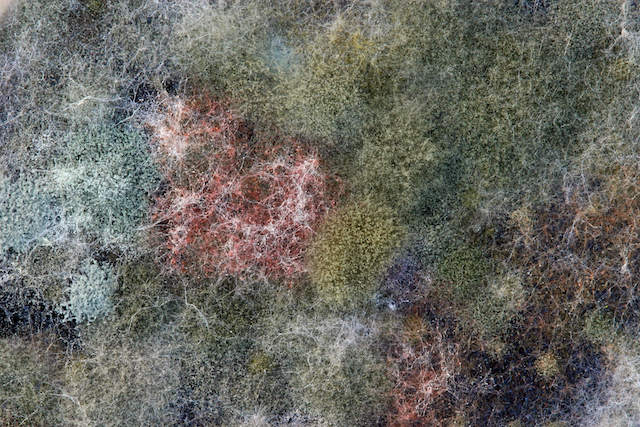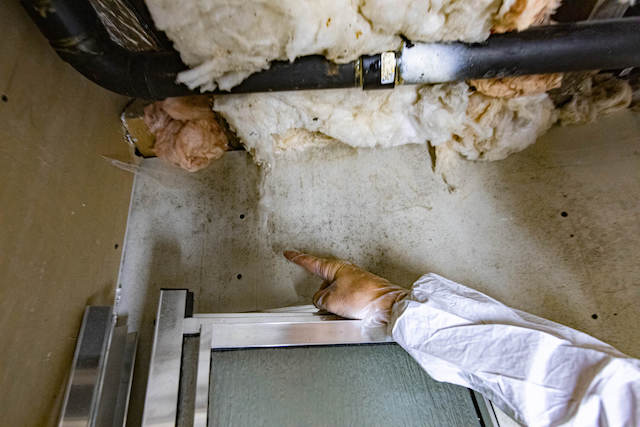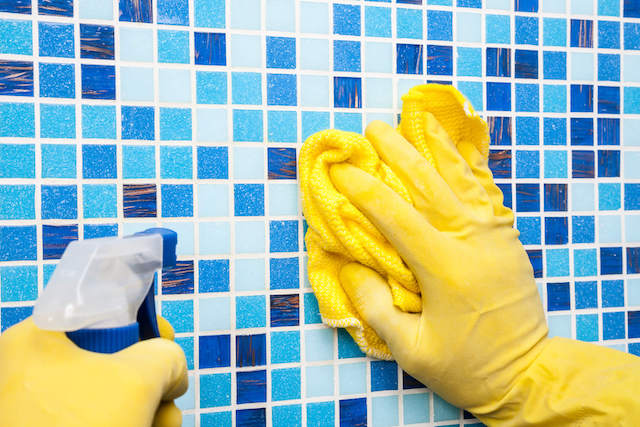Most college residential areas aren’t exactly the pinnacle of luxury. It’s almost a rite of passage to have to deal with new roommates, bland walls, and lackluster water pressure during those undergraduate years of university. What should not be included in this list of less than inspiring amenities are health hazards. With mold in college dorms on the rise, students may be headed into a situation far more impactful than staying on top of their higher education.
Navigating these higher educational institutions is hard enough without having to deal with the health effects of living in a toxic environment. Not to mention the cost involved in paying for these spaces that are filled with indoor contaminants like mold and bacteria. This perfect storm can not only lead to chronic symptoms but also impact a student’s ability to perform academically.
It’s a bit difficult to study and complete assignments when your immune system is currently waging war on an army of foreign particles that are entering the body every time the student steps into their room. Yet this issue has still not gained the attention it deserves or the changes needed to keep these young adults safe.
For more information on just how prevalent this issue is and why it’s a nationwide epidemic, check out this blog post.
To keep yourself or your child safe, it’s important to increase your awareness so that you know what to look out for, how to prevent indoor mold growth, and what to do if contamination occurs.
Looking For Mold in College Dorms
Checking for mold should be done on the very first day that the student moves in.
After this initial check, college students should regularly check all moldy hotspots in their dorm room and bathroom to ensure no contamination problems are popping up. The sooner a problem is identified, the less contamination there will be, resulting in lower exposure.
That being said, make sure to grab a flashlight and channel your inner investigator for this three-part process. When it comes to ensuring your environment is safe, there’s no such thing as "over the top." It’s your health on the line, after all.
Do a Visual Inspection
Use that flashlight and look at every little crack and crevice in the dorm and bathroom. Keep in mind that you’re not only looking for mold but also water damage as well. Where there’s moisture, there’s an opportunity for this fungus to grow.

When it comes to visible mold, look for any discoloration or abnormalities. With over 100,000 species out there, mold can come in all sorts of colors, shapes, and textures, so look for any sort of abnormality. Some of the most common colors include green, white, grey, blue, red, black, brown, or the infamous pink. As for textures, they could be fuzzy, powdery, velvety, or slimy.
As for water damage, visible issues that indicate a moisture problem include:
- Coffee-like stains on ceilings or walls
- Discolored carpeting
- Peeling, cracked, or bubbling wallpaper
- Peeling or bubbling paint
Some of the top areas to check for problems include:
- Window AC units
- Ceilings
- Closets
- Underneath beds
- Windowsills and door frames
- Air vents
- Underneath sinks
- Inside cabinets
- Grout and caulk
- Toilet tank
Basically, anywhere you can access, you should take a close look.
Does it Smell In There?
If you don’t find any visible mold, that doesn’t mean that there isn’t a problem. The growth could be in a hidden location like the inside of a wall or be too small to be visible yet.
In this case, rely on your nose. Mold growth often creates a damp, musty, earthy smell due to the release of gases called microbial volatile organic compounds (MVOC).¹ If you smell it in the space, there’s a good chance that you’re dealing with mold in college dorms.
How Do You Feel?
Not all mold growth will be visible, and not all mold growth will create a smell. In cases like this, pay attention to your body and how you feel. Did you walk into the room and feel off? Have you developed chronic symptoms over time that no doctor can pinpoint a root cause for? Do they flare up anytime you go into the dorm?
Our bodies are amazing warning systems that will let us know when something is wrong. If you start feeling unwell, those invisible particles could be making their way inside of your body and wreaking havoc, causing your immune system to sound the alarm and push for you to get out of that situation. Always listen to your body when it’s saying, "Hey, something is definitely not right here. We need to go."
What to Do If You Find Mold in College Dorms
A good rule of thumb is to assess what guidelines the institution has when it comes to dealing with mold in college dorms before you move to campus. That way, you’ll know if they’re taking this issue seriously and whether or not they’re prepared to accurately handle any situation that pops up. A college with your health in mind should have a plan of action in place, crafted by consultations with experts, to correctly handle the problem.
If it’s your first day in the dorm, do not move your things in until this situation is resolved. As soon as your belongings are inside, all of those particles will make their way onto the surfaces and contaminate them. This means everything will need to be deep cleaned and, for those who are experiencing reactions from exposure, many will need to be tossed out and replaced.
For anyone who finds mold in college dorms, alert the institution ASAP. Whether that be University Housing or Environmental Services, let them know that there’s a problem and it needs to be addressed as quickly as possible. The longer you’re in that space, the more contaminants will enter your body.
Ask to be relocated immediately until the issue is resolved or transfer dorm rooms if you’re not confident that they can handle the problem properly.
No Response?
If you don’t hear back promptly, start making calls to other departments or show up in person at the office. Again, there’s no such thing as going over the top when it comes to these issues. If nothing comes of this, that’s when the situation becomes tricky. The lack of laws and regulations regarding indoor environments and contaminants like mold makes requesting correct action difficult.
One option is contacting a "toxic tort" attorney in your area who can advise you of your rights. Unfortunately, the rights vary from state to state, so you’ll need someone who is knowledgeable and able to handle specific regulations in your area. With these in hand, you can start down the right path to make sure you have safe housing.
Another option is to contact local news departments to shine a light on the issue. Speak with other students to see if they’re having issues as well, and check to see if the campus has a history of mold-related issues in their dorms or other facilities.
Finally, consider hiring your own mold inspector or completing at-home tests to determine the extent of the problem. The more data you can gather to back up your case, the better.
Basically, do whatever you can to sound the alarm on this issue and ensure that it’s addressed. And in the meantime, limit exposure as much as possible by staying out of the room, deep cleaning to remove contaminants, and working on improving the air quality.
Dealing With Mold in College Dorms
Unfortunately, the lack of awareness regarding this issue has resulted in far too many students continuing to suffer from toxic dorm rooms because the contamination was not handled properly.
Mold growth should be handled quickly to avoid any health issues and to prevent contamination from spreading to other areas in the building. The key here is to address the problem correctly and not look for a quick fix. That’s just asking for problems and, more than likely, will not get rid of the mold.
Step One For Dealing With Mold in College Dorms
If mold growth is discovered, the university should hire a qualified mold inspector to come in and assess the problem. They could be dealing with just that small area of mold growth or looking at a more widescale problem. Additionally, with how easily mold spores and toxins move invisibly throughout the air, the contamination could have made it to the other dorm rooms nearby. All of these scenarios qualify as exposure and could cause adverse health reactions in students.

The mold inspector should use a variety of measuring techniques to determine if there are other problem areas and what the contamination level is in the dorm. This includes the volume of mold spores present, mold species, mycotoxins, and bacterial presence. The data they collect will give the college the necessary information to determine the next steps. Is it a problem they can handle, or does a remediation team need to come in?
Step Two For Dealing With Mold in College Dorms
From there, they should have two courses of action planned out. Both of which should be formed by experts.
If the mold can be handled by the college, they should understand how to properly remove the mold and decontaminate the area.
There are a few points to keep in mind here.
- The source that led to the mold growth must be resolved. Otherwise, the issue will grow right back.
- Killing mold is not the answer. Even dead mold can result in exposure, which is why bleach should never be used to deal with mold contamination.²
- Mold grows roots called hyphae that can reach deep into surfaces. Like a weed, it needs to be removed by the roots; otherwise, exposure will continue, and/or the mold could grow back.
- Mycotoxins and bacteria require an extensive process to remove. At least three times should be done to remove the issue.
- The sources released particles all over the room, so the entire space must be deep cleaned to remove the contamination.
- Student belongings will also need to be properly sanitized to remove any mold particles and byproducts.
- If any porous material is molded, it needs to be removed and replaced. These are almost impossible to fully decontaminate.
Should the college not understand this, or use a cleaning protocol that does not deal with each of these issues, they did not handle the situation correctly.
If the college needs to hire a qualified remediation company, they should know that not all remediation companies are built the same. The team they go with should be able to handle the issue properly and thoroughly so the students are safe to return.
A quick and easy test is to see if they stand on these three pillars.
- Remediate the sources and mold properly
- Identify and address the problems that led to the sources in the first place (otherwise, the mold will just grow back)
- Eradicate all contamination that exists from the mold problem, including mycotoxins and bacteria
Failure to hit those points means the remediation was not successful and students could continue to suffer.
For students and parents, stay up-to-date on exactly what colleges are doing to address mold problems. They should be giving you a play-by-play of their decisions and actions to handle the mold growth and ensure that they’re creating safe and healthy indoor living spaces. If you’re concerned they’re not going about the mold removal correctly, contact an expert for their opinion.
Finally, students dealing with mold in college dorms should thoroughly decontaminate their belongings after remediation is complete.
Step Three For Dealing With Mold in College Dorms
If you’re dealing with any chronic symptoms after discovering mold in college dorms, contact a qualified medical professional who is experienced in helping individuals with environmental-related exposures like mold. This person will be able to help you start down the path of detoxing so that your body can heal.
Again, remember that the body will not be able to fully heal if you continue to live in the space that’s making you sick in the first place. Those contaminants will continue to make their way inside while you’re working hard to get rid of them.
Dealing With Small Issues
If there’s a small issue you think you can handle, like grout in the bathroom, make sure that you correctly remediate the issue so that the mold doesn’t just grow right back.

For non-porous surfaces like sealed countertops, spray a botanical cleaner like Benefect Decon 30 on the surface, allow this to sit for 30 seconds, and then wipe with a microfiber towel. Microfiber towels are 100 times more effective at wiping away small particles than regular rags. Repeat the process at least three times to ensure all contaminants are removed.
For semi-porous surfaces, it’s a little more tricky because the roots of the mold can grow into the surface itself and be difficult to remove completely, so the university may need to step in to handle the situation. Use the technique mentioned above and, if possible, the surface should be sealed. Some surfaces, like wood, require abrasive techniques are required to get rid of the roots. For surfaces with grout or caulk, it’s best to use hydrogen peroxide to help lift the particles to the surface so that they can be wiped away.
Keep a close eye on these surfaces, though, to see if the mold comes back. If it returns quickly, the colony could have permeated deep beneath the grout or there could be a larger problem elsewhere. Either way, you can attempt to clean it again, but it may be time to call the university and replace the surface/item entirely.
For porous surfaces, it’s best to remove and replace the item. The contamination can exist deep within the fibers and be nearly impossible to completely remove. If you want to attempt to clean it, use a HEPA vacuum cleaner thoroughly on the surface and throw it in the wash with a botanical laundry additive like EC3.
Avoiding Mold in College Dorms
The best way to avoid mold in college dorms is to prevent it from occurring in the first place.
How Can Students Prevent Mold in College Dorms?
Mold prevention is probably not high on any student’s to-do list, but it should be! The cleaner the spaces are, the healthier they will be and the fewer opportunities there will be for mold growth.
These steps include:
- Creating daily and deep cleaning schedules and sticking to them
- Using proper cleaning products, including EPA-approved botanical cleaners, HEPA vacuums, and microfiber towels
- Wiping up any spills asap
- Not letting wet clothing, towels, or umbrellas sit around- hang them up to dry thoroughly
- Getting an air purifier to regularly remove particles from the indoor air- make sure it will actually remove these small particles and eliminate them all of the time, not just some of the time
- Maintaining indoor humidity levels of 35-50%³
- Keeping windows and doors closed when the AC is on
- Turning on the exhaust fans while showering and if possible, crack a window or door
- Investing in dehumidifiers for the bathroom if there are no exhaust fans/the humidity just will not go down or ask for the university to provide one (make sure to regularly clean these!)
- Checking for any leaks at least once a month.
- Cleaning the window AC unit regularly
- Not frequently fluctuating the temperature in the room(this can lead to condensation)
- Not blocking airflow
- Using exhaust fans whenever cooking, dishwashing, and cleaning
This isn’t an exhaustive list, but it’s a great start toward creating a healthier and safer indoor space. From there, it’s up to the campus to mitigate moldy opportunities.
How Can Colleges Prevent Mold in College Dorms?
If you’re a college student or parent, always make sure that the campus is actively taking steps to avoid mold in college dorms. They should understand exactly how important it is for the health of their students and have a plan of action in place as well as experts to consult to make sure they’re doing everything they can to ensure that there’s no mold in college dorms.

These actions can include:
- Fixing any leaks or spills immediately and properly.
- Regularly checking for any leaks, cracks in the foundation, or weak spots in the building that could lead to moldy problems.
- Maintaining indoor humidity levels between 35-50%.
- Opting for the highest rated MERV filters the HVAC system can handle and changing these on time.
- Servicing the HVAC system to ensure it’s running properly and that there’s no mold.
- Cleaning the Clean HVAC drip pans and coils to remove condensation.
- Ensuring there’s adequate ventilation in the building.
- Educating students on how they can help prevent mold growth and providing them with appropriate supplies.
- Updating outdated systems and building components, like the HVAC, window AC units, plumbing, and roofing, so they don’t malfunction or break down and cause massive water events.
- Hiring a mold inspector to come in regularly and assess for any hidden problems.
- Venting bathroom, kitchen, and other moisture-generating sources outside of the building.
- Reducing carpeting in the building.
There are other actions college campuses can take to help prevent mold in college dorms, but these steps are a good start. Not only can prevention keep students safe, but it also saves money in the long run from remediation, rehousing, and potential lawsuits.
A Healthy Education
Going to college is stressful enough. Between cramming for tests, participating in extracurriculars, and maintaining a social life, the last thing any student wants to deal with is mold in college dorms. It’s a hassle for sure. But suffering from chronic symptoms due to toxic indoor environments will also taint those core memories with continually feeling unwell.
Students can’t exactly enjoy these years or focus on excelling when they’re sick day in and day out. Knowing how to prevent mold growth and what steps to take if it pops up in a dorm can help students focus on what matters most: maturing, making memories, and setting the foundation for their future. A little bit of awareness can go a long way towards achieving their goals.
At the end of the day, an entire overhaul is needed to change the current narrative regarding mold in college dorms. Until this change is made, unfortunately, it's up to students, parents, and universities to work together to solve this health crisis.
Citations:
- Environmental Protection Agency. (n.d.). What does mold smell like? EPA. Retrieved from https://www.epa.gov/mold/what-does-mold-smell.
- EPA. (n.d.). Should I use bleach to clean up mold? EPA. Retrieved from https://www.epa.gov/mold/should-i-use-bleach-clean-mold.
- EPA. (n.d.). A Brief Guide to Mold, Moisture, and Your Home. EPA. Retrieved from https://www.epa.gov/mold/brief-guide-mold-moisture-and-your-home#tab-6.

